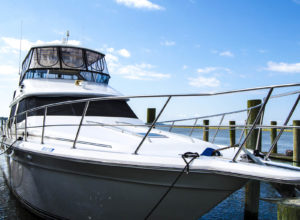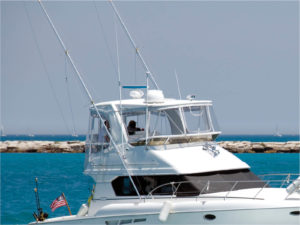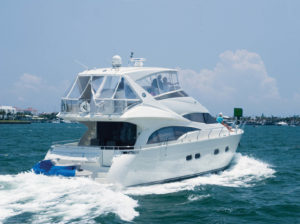Windows on the water
 Product knowledge and best practices lead to stunning results and happy customers.
Product knowledge and best practices lead to stunning results and happy customers.
Whether on the lake in a trusty fishing vessel or soaking up ocean views from a luxury yacht, boat owners want the best windows for their crafts. Product manufacturers, distributors and fabricators have great material options to meet their customers’ marine window goals. Furthermore, best practices in patterning, material handling, sewing, installation and maintenance ensure that those windows withstand marine environments.
Window solutions
Marine window manufacturers and distributors are delivering a variety of vinyl, polycarbonate and acrylic solutions for fabricators. Numerous companies offer products that will complement fabricators’ window goals. These companies include Bruin Plastics Co. Inc., Grand Junction, Colo.; EZ2CY Inc., Riviera Beach, Fla.; Manart-Hirsch Co. Inc., Lynbrook, N.Y.; O’Sullivan, Winchester, Va.; Rainier Industries Ltd., Tukwila, Wash.; Robeco, Garden City, N.Y.; Strataglass LLC, Fort Lauderdale, Fla.; and Vicar International, Union, N.J.
Options abound
Most roller vinyl options come in 20, 30 and 40 mil thicknesses in both clear and smoke tint. “These are most frequently used for drop curtains, side curtains, aft curtains, bimini tops, dodgers, and other marine applications where a see-through application is applicable, such as sail curtains,” says Vicar president Richard Greenberg.
Fabricators have access to a variety of coated and uncoated clear vinyl options for their customers available in press-polished polyvinyl sheets (flexible clear vinyl). These sheets are “engineered to be scratch resistant, durable and resistant to the damaging effects of the sun’s rays,” says Randy Bouffler, who handles sales for Strataglass, a subsidiary of Herculite Products Inc., in Fort Lauderdale, Fla. Products are made with features that enhance visibility, reduce sun glare and improve low-light visibility. Sheets are available in thicknesses of 30, 40 and 60 mil, with options for tints, usually light and dark smoke.
 In addition to offering scratch-resistance, some makes of window products are coated to enhance durability and withstand chemicals such as jet fuel and suntan oils.
In addition to offering scratch-resistance, some makes of window products are coated to enhance durability and withstand chemicals such as jet fuel and suntan oils.
Beyond vinyl, polycarbonate “has taken on strong momentum in the past 10 years,” says Richard Hirsch of Manart-Hirsch. UV coating adds protection against the sun’s rays that can turn some polycarbonate products brown over time.

Patterning and handling best practices
Fabricating boat windows requires a host of considerations that differ from working with other types of marine fabrics. When it comes to patterning, “It is important to take into account the window lines, size of panels, ventilation and how the customer will use their boat and recommending which product best suits their needs,” says Chandler Clark, owner of Signature CanvasMakers, Hampton, Va.
For its EZ2CY impact-modified acrylic enclosures, Canvas Designers Inc., Riviera Beach, Fla., has digitized about 75 percent of its patterns. “Even if we take manual patterns, our CAD guys take a picture of them with a high-resolution camera and clean them up,” says Mickey Garrison, field supervisor and sales manager at Canvas Designers Inc.
Quality fabrication also relies on proper material handling—particularly with uncoated vinyl. “Clear vinyl fabrics feature optical clarity and are flexible, but it is this flexibility and softness that makes the products susceptible to scratching and damage,” says Craig Zola, vice president marketing and distribution for Herculite.
Eric Walton, MFC, partner at Custom Canvas Alaska LLC in Fairbanks, Alaska, understands this challenge firsthand. His shop fabricates the majority of windows—installed primarily in boat-top enclosures for riverboats and airboats—using marine-grade 20-mil vinyl with a -20°F cold crack.
To keep the clear vinyl scratch free during fabrication, Custom Canvas Alaska uses a product that is PVC with a leather-like grain on one side, and the other side has a soft, fuzzy layer. Once the project gets to the point where the clear vinyl will be on the table, the fabricator rolls out the product and lays the side curtain/back curtain on top of it.
When unloading press-polished sheets, Julie Tinsman, representative for O’Sullivan Films, advises that fabricators take care to remove window products from their packaging, never pulling individual sheets from a drum. Instead, to prevent scratches across the narrow width of the sheet, Tinsman recommends wearing cotton gloves while handling the sheets, carefully laying all the sheets onto a smooth, flat table, where they will uncurl. For sheets measuring 54-inches x 110-inches, no more than five sheets should be stacked on top of each other.
“Leaving sheets stacked on a table flat for more than one hour puts weight on the lower sheets and could cause the interleaving paper to leave an impression on the sheet’s surface,” she adds.
To further protect the product before it is sewn, O’Sullivan’s packaged sheets are interleaved with high-quality commercial-grade paper that resists tearing during handling. Throughout the fabrication process, O’Sullivan Films suggests that the interleaved paper should remain with the press-polished sheets to protect the surface and prevent blocking. “Some canvas shops even use the interleaving sheets to cut out their templates for their windows,” Tinsman notes.
Best practices in patterning, material handling, sewing, installation and maintenance ensure that windows withstand marine environments.
Needle and thread know-how
According to Hirsch, all vinyl window products can be sewn with a standard industrial sewing machine with needle sizes between 19 and 22.
Fabricators that work with Herculite products say that size 17 and 18 needles work very well, according to Zola. “Cost-effective polyester threads in V92 and V138 work very well, and Teflon® sewing threads offer further value to their customers with a thread that is impervious to UV rays and chemicals,” he says.
O’Sullivan Films says that canvas shops can sew their 80-mil sheets without using a special diamond-cut needle. “With other thicker gauge and rigid materials, you have to waste time switching out needles,” Tinsman says. “A standard needle will work fine on O’Sullivan Films’ press-polished clear vinyl.” Furthermore, a sewing machine with a height adjustment can be beneficial for thicker materials, but it’s not necessary.
When sewing polycarbonate, Hirsch recommends a size 22 needle with a tri-point tip. Although polyester threads sew well with most projects, PTFE thread “has become the thread of choice due to its longevity,” Hirsch adds.
From a sewing machine standpoint, “installing an electronic servo motor can also help in the use of any polycarbonate, as the sewer has much more control of the sewing process vs. a clutch motor,” Hirsch says.
Signature CanvasMakers, which fabricates windows made of scratch-resistant pressed polish, polycarbonate and acrylic, sews only with PTFE thread. For sewing clear vinyls, the fabricator uses 2000 denier thread and a size 19 diamond tip needle. “We have found that our customers are happy to pay for premium products as long as they are educated on the differences,” Clark says.
Installation pointers
When the time comes to install vinyl windows, fabricators should aim for a warm day, as the vinyl will be in a more relaxed state. As Herculite’s Bouffler puts it, “A tight installation on a warm day will result in a great-fitting enclosure year-round. If installing on a cool day, it may be too tight to connect all the fasteners.”
In those instances, Bouffler recommends a heat gun or hair dryer to warm the surface and make the vinyl more pliable to complete the tight stretches. “Wrinkles and slight blemishes can sometimes be remedied with an application of heat,” Bouffler says.
On occasion, when replacing extremely old, shrunken, yellowed windows in back curtains, Custom Canvas Alaska will completely remove the old window and stake out the curtain. Once the curtain is staked out, the fabricator uses double-sided tape around the opening. “Leaving the release paper on, we lay out the new ‘glass’ on top,” Walton explains. “We’ll peel off the release paper, sticking the new glass to the old cover, and sew and trim.”
Holly O’Dell is a freelance writer and editor based in Joshua Tree, Calif.
 TEXTILES.ORG
TEXTILES.ORG 






